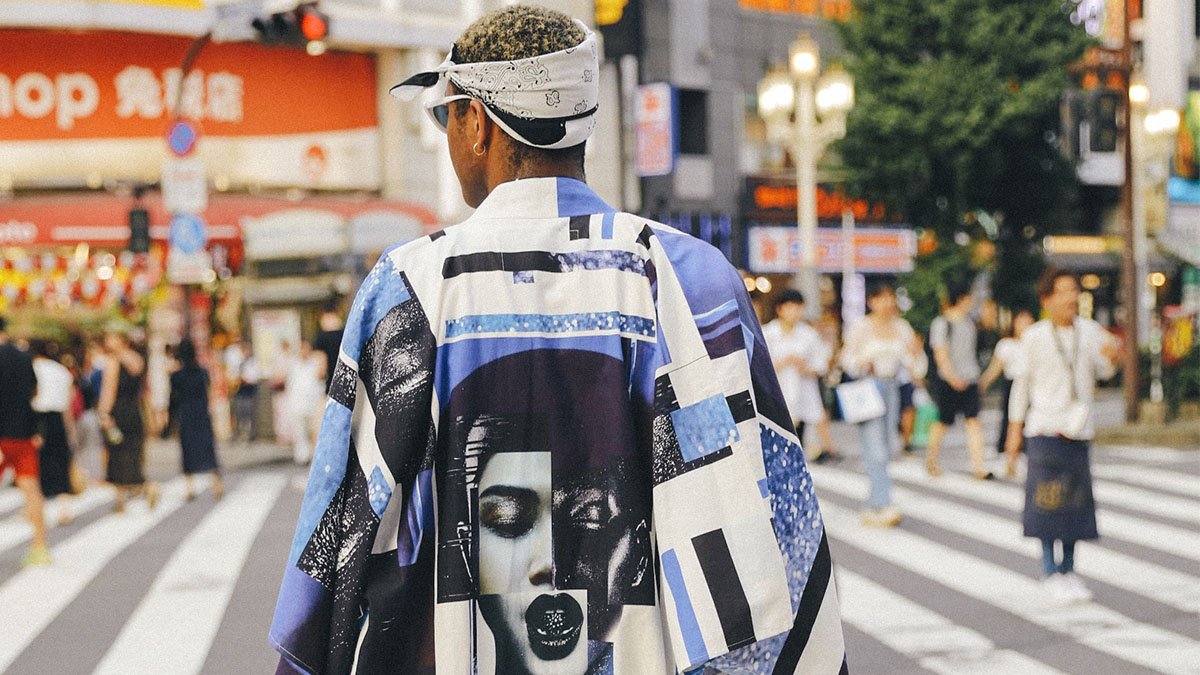

A Kimono Revolution
Tokyo-Kanto

Area
The Futuristic Heart of Japan
Tokyo is one of the truly great cities of the modern world; it is an enormous urban canvas that thrills with its architecture, sights, sounds and intensity. Contemporary Tokyo is, in many ways, a place of the future, of innovation and excitement.
However, hidden just below this futuristic exterior is a place rich in history and tradition. And much of what makes Tokyo so compelling is the inextricable link between the city's past and its present. It is perhaps no surprise then that Tokyo produces a seemingly endless stream of world-class writers, artists and designers in every imaginable field, informed sometimes by tradition but always with an eye on the future.

History
New Views on Traditional Clothing
Veduta means 'view' in Italian; Masashi Watanabe, the founder of the company, chose this word, as his aim is to alter perceptions about Japanese traditional clothing and create a new view of how and where to wear them. His journey to this realization came after he moved to Milan to study western fashion. Masashi soon noticed that there was a strong appetite for Japanese history and fashions abroad, and simultaneously that his heart lay with his homeland and its remarkable traditional clothing.
Masashi speaks about a frustration that the kimono-based clothing worn for centuries in Japan was jettisoned in a matter of decades in the early 20th century. Nowadays, most Japanese people predominantly wear western-style clothes. But Masashi hopes to change this with his modern, expressive kimonos; and he believes that one day he may once again see the streets of Japan full of people wearing kimonos. From there, who knows? Perhaps he can change people's views abroad too and get the rest of the world to adopt the kimono.

Characteristic
At the Nexus of Past and Future
Masashi Watanabe's clothes are defined by energetic, bold patterning that gives his kimono and yukata-based styles a very contemporary focus. He has collaborated with a range of animators, DJs and designers who lend a powerful modern expressiveness to all his clothing. His time in Milan also plays a part in some of his designs that use beautiful Italian baroque imagery to create an engaging contrast between Japanese and European tradition.
But Masashi sees himself at the nexus of past and future, and works with a host of traditional artisans to keep his work in touch with Japan's rich craft heritage. All the material, embroidery and printing of his designs is produced in Japan; the obi (kimono belts) are made by 'shimenawa' craftsmen, who famously create the enormous rope plaits at Shinto shrines. Also, he has engaged with calligraphers from his home island of Sadogashima and artisanal dyers to work on his clothes. In all of this, Masashi aims to reframe what tradition means in modern Japan.

For Customers
Versatile Styles for Modern Living
Veduta's kimono-inspired clothes are visually stunning and coordinate with wardrobe staples to create a bold and expressive look; this is traditional clothing but free from all convention. Unlike kimono, there's no special knowledge or techniques needed to wear these. Masashi has designed them so they can be easily tied with the rope belts (obi).
Each piece is made from lighter, more durable materials than a traditional kimono would be, creating something that can be worn over other tops and trousers. A Veduta gown is a very versatile addition to any cutting-edge street wear, and something that encapsulates the pulsing, modern city of Tokyo.

![HAORI: PANTHER (MADE-TO-ORDER 3 WEEKS) [KIMONO]](http://store.jtbusa.com/cdn/shop/products/file058_2_2cfa1b2e-ea60-4e27-8588-ebea319a0d5a_{width}x.jpg?v=1656465618)
![HAORI: PANTHER (MADE-TO-ORDER 3 WEEKS) [KIMONO]](http://store.jtbusa.com/cdn/shop/products/panther009_24b70782-c7e6-4174-b711-6ae4160caf6b_{width}x.jpg?v=1656465618)
![INDUSTRIAL BELT OBI: BLACK (WITH CLEAR POUCH) [KIMONO]](http://store.jtbusa.com/cdn/shop/products/veduta_0001_S0003-148_{width}x.jpg?v=1656528131)
![INDUSTRIAL BELT OBI: BLACK (WITH CLEAR POUCH) [KIMONO]](http://store.jtbusa.com/cdn/shop/products/K4A3188_8e5e14b6-8af5-4d93-81fe-56c7b96e371a_{width}x.jpg?v=1656528131)
![LIFE GOES OFF (BLACK) [GOWN KIMONO]](http://store.jtbusa.com/cdn/shop/products/s0003-169-1_{width}x.jpg?v=1656519712)
![LIFE GOES OFF (BLACK) [GOWN KIMONO]](http://store.jtbusa.com/cdn/shop/products/s0003-169-2_{width}x.jpg?v=1656519712)
![LIFE GOES OFF (GRAY) [GOWN KIMONO]](http://store.jtbusa.com/cdn/shop/products/s0003-170-1_{width}x.jpg?v=1656519682)
![LIFE GOES OFF (GRAY) [GOWN KIMONO]](http://store.jtbusa.com/cdn/shop/products/s0003-170-2_{width}x.jpg?v=1656519682)
![7 LIGHTS TILL NIGHT [GOWN KIMONO]](http://store.jtbusa.com/cdn/shop/products/s0003-172-1_{width}x.jpg?v=1656519623)
![7 LIGHTS TILL NIGHT [GOWN KIMONO]](http://store.jtbusa.com/cdn/shop/products/s0003-172-2_{width}x.jpg?v=1656519623)
![STAY HOME YUKATA: KLIMT [KIMONO]](http://store.jtbusa.com/cdn/shop/products/K4A2664_e991cc01-c4df-4d4f-bd57-039c13fa0c25_{width}x.jpg?v=1656528171)
![STAY HOME YUKATA: KLIMT [KIMONO]](http://store.jtbusa.com/cdn/shop/products/K4A2677_76ab491c-3b42-44c9-a8e0-5b9dd518b8a2_{width}x.jpg?v=1656528171)
![LIFE GOES OFF (GRAY) [JACKET & WIDE PANTS KIMONO]](http://store.jtbusa.com/cdn/shop/products/s0003-183-14_{width}x.jpg?v=1656519452)
![LIFE GOES OFF (GRAY) [JACKET & WIDE PANTS KIMONO]](http://store.jtbusa.com/cdn/shop/products/s0003-183-2_{width}x.jpg?v=1656519452)
![LILY OF DA CITY VALLEY [JACKET KIMONO]](http://store.jtbusa.com/cdn/shop/products/s0003-165-2_{width}x.jpg?v=1656519813)
![LILY OF DA CITY VALLEY [JACKET KIMONO]](http://store.jtbusa.com/cdn/shop/products/s0003-165-1_{width}x.jpg?v=1656519813)
![SUEDE (BLACK) [WIDE PANTS KIMONO]](http://store.jtbusa.com/cdn/shop/products/s0003-177-1_{width}x.jpg?v=1656519518)
![SUEDE (BLACK) [WIDE PANTS KIMONO]](http://store.jtbusa.com/cdn/shop/products/s0003-177-2_{width}x.jpg?v=1656519518)
![SUEDE (NAVY) [WIDE PANTS KIMONO]](http://store.jtbusa.com/cdn/shop/products/s0003-178-1_{width}x.jpg?v=1656519513)
![SUEDE (NAVY) [WIDE PANTS KIMONO]](http://store.jtbusa.com/cdn/shop/products/s0003-178-2_{width}x.jpg?v=1656519513)
![SWEAT (GRAY) [WIDE PANTS KIMONO]](http://store.jtbusa.com/cdn/shop/products/s0003-181-1_{width}x.jpg?v=1656519497)
![SWEAT (GRAY) [WIDE PANTS KIMONO]](http://store.jtbusa.com/cdn/shop/products/s0003-181-2_{width}x.jpg?v=1656519497)
![FACE 2 FACE [MASK]](http://store.jtbusa.com/cdn/shop/products/s0003-166-1_{width}x.jpg?v=1656519789)
![FACE 2 FACE [MASK]](http://store.jtbusa.com/cdn/shop/products/s0003-166-2_{width}x.jpg?v=1656519789)
![INDUSTRIAL BELT OBI: WHITE (WITH CLEAR POUCH) [KIMONO]](http://store.jtbusa.com/cdn/shop/products/veduta_0000_S0003-149_{width}x.jpg?v=1656528124)
![INDUSTRIAL BELT OBI: WHITE (WITH CLEAR POUCH) [KIMONO]](http://store.jtbusa.com/cdn/shop/products/K4A3188_0cdea00e-f145-468d-8da6-708208304cdd_{width}x.jpg?v=1656528124)
![INDUSTRIAL BELT OBI: ORANGE (WITH CLEAR POUCH) [KIMONO]](http://store.jtbusa.com/cdn/shop/products/veduta_0003_S0003-150_{width}x.jpg?v=1656528116)
![INDUSTRIAL BELT OBI: ORANGE (WITH CLEAR POUCH) [KIMONO]](http://store.jtbusa.com/cdn/shop/products/K4A3188_860e9053-abd6-4222-a978-5d1622b8192c_{width}x.jpg?v=1656528116)
![INDUSTRIAL BELT OBI: GREEN (WITH CLEAR POUCH) [KIMONO]](http://store.jtbusa.com/cdn/shop/products/veduta_0002_S0003-151_{width}x.jpg?v=1656528105)
![INDUSTRIAL BELT OBI: GREEN (WITH CLEAR POUCH) [KIMONO]](http://store.jtbusa.com/cdn/shop/products/K4A3198_{width}x.jpg?v=1656528105)